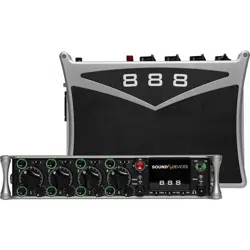Loading ...
Loading ...
Loading ...

888 User Guide
42
Ethernet
A family of computer networking technologies. Ethernet commonly
refers to the physical interconnection of the network typically using
twisted-pair copper connections on CAT cable with RJ-45 connectors.
Common Ethernet data speeds include 10 Mbs, 100 Mbs, and 1000
Mbs.
exFAT
A storage volume format that can be read and written from current
versions of MacOS and Windows. exFat supports volume sizes up to
128 PB (gigantic), and individual les can have a maximum size of 16
EB (even more gigantic, bigger than the maximum volume size).
Fader
A physical control on a mixing console, either a rotary or sliding
potentiometer, that controls the level of a channel to a bus. Most
faders have more attenuation than gain available and a unity gain
position where the input trim level established the level to the bus.
False take
A recorded take that was either erroneously recorded, or a take that
needs to be repeated. It can be labeled after recording. An identied
false take is moved to the trash bin and the auto-incrementing take
number is reset to the value prior to the false take.
File list
Every le recorded by a recorder is visible in the le list. It can be
viewed either on a recorder or from a computer when the recording
volume is mounted. The le list shows all the individual les recorded
by a recorder.
Frame rate
The rate at which video or motion picture images are recorded or
played back, measured in frames-per second (FPS). All audio and
video devices must be running at the same frame rate to keep audio
and video synchronized. Timecode frame rates are either an integer
or non-integer value. Integer values include 24, 25, and 30 FPS. Non-
integer frame rates include 23.976 and 29.97, and 29.97 drop FPS.
Frequency
The period at which a wave oscillates, measured in hertz (Hz).
Frequencies audible to humans range from 20 Hz for very low
frequency signals to 20 kHz for very high frequency signals.
Gain
An increase (or decrease with negative gain) in the level of an audio
signal. Gain can be applied in several locations, to both analog
and digital signals. In a eld mixer the microphone preamplier
provides a substantial amount of gain at the trim to raise the low
level microphone signal to a usable signal in the mixer. Gain is also
available at the fader. Gain of digital signals or line level analog
signals is often limited. Unity gain is gain stage that neither adds or
subtracts level from a signal.
Headphone monitor
Often a separate bus with a dedicated headphone volume control,
the headphone monitor typically is normalled to the main left/right
output bus of a mixer. Headphone sources can often be selected
among soloed tracks or buses. In some products complex headphone
monitoring of MS Stereo, LR stereo, and ambisonic sources is
available.
High pass lter (audio)
Also referred to as a low-cut lter, this circuit reduces the amount of
low frequency content in an audio signal. A HPF is particularly useful
when recording speech since the human voice does not generate
appreciable energy at low frequencies. The HPF reduces non-speech
signals such as environmental noise, wind noise, and microphone
handling noise, improving the intelligibility of speech and reducing low
frequencies from overloading the input. The high pass lter is placed
in the circuit close to the microphone preamplier.
High pass lters are often frequency selectable, ranging from 20 Hz to
200 Hz. HPF also have a slope, generally from 3 dB/octave to 18 dB/
octave. Greater/steeper slopes offer more attenuation of frequencies
just below the set lter frequency.
Input
The physical connection and associated signal type from external
sources connected to a device. Inputs can include microphone inputs
on XLR connectors, Dante inputs on audio-over-Ethernet, and USB
audio inputs from a computer. Depending on the architecture of the
mixing console its inputs may be hardwired to channels or channels
can be selected from different inputs.
Input limiter
A limiter circuit reduces the peak signal levels of audio, generally to
prevent signal overload. Analog inputs have a maximum input signal
level that can be reached before overload/distortion is introduced.
Setting the input gain correctly so that input signals do not reach this
maximum level prevents most overload conditions. In the presence of
very high, unexpected signals an input limiter changes the gain of the
incoming signal and prevents it from overloading. Input limiters are
sometimes compressor-type circuits with a ratio of innity:1, meaning
that any increase to the input signal into the limiter at the limiter
threshold does not increase the output signal of the limiter.
Several parameters may be available in a limiter, including knee, ratio,
release, and threshold.
Isolated track
A recorded track of an individual microphone or sound source. “ISO”
recordings allow for post-record mixing of individual sound elements.
iXML
An extensible data schema for audio and related metadata stored
in broadcast WAV les. Manufacturer-specic data generated during
recording is stored in iXML.
Line level
An analog audio signal used to interconnect audio equipment. Line
level may be balanced or unbalanced, referenced to +4 dBu or -10
dBV, professional or consumer respectively.
Low cut lter
See high pass lter.
Microphone level
The audio signal generated by a microphone. Mic level signals are
very low level, requiring a microphone preamplier to bring them to
usable, line levels. Interconnects with microphone level signals can be
subject to noise and interference.
Loading ...
Loading ...
Loading ...
